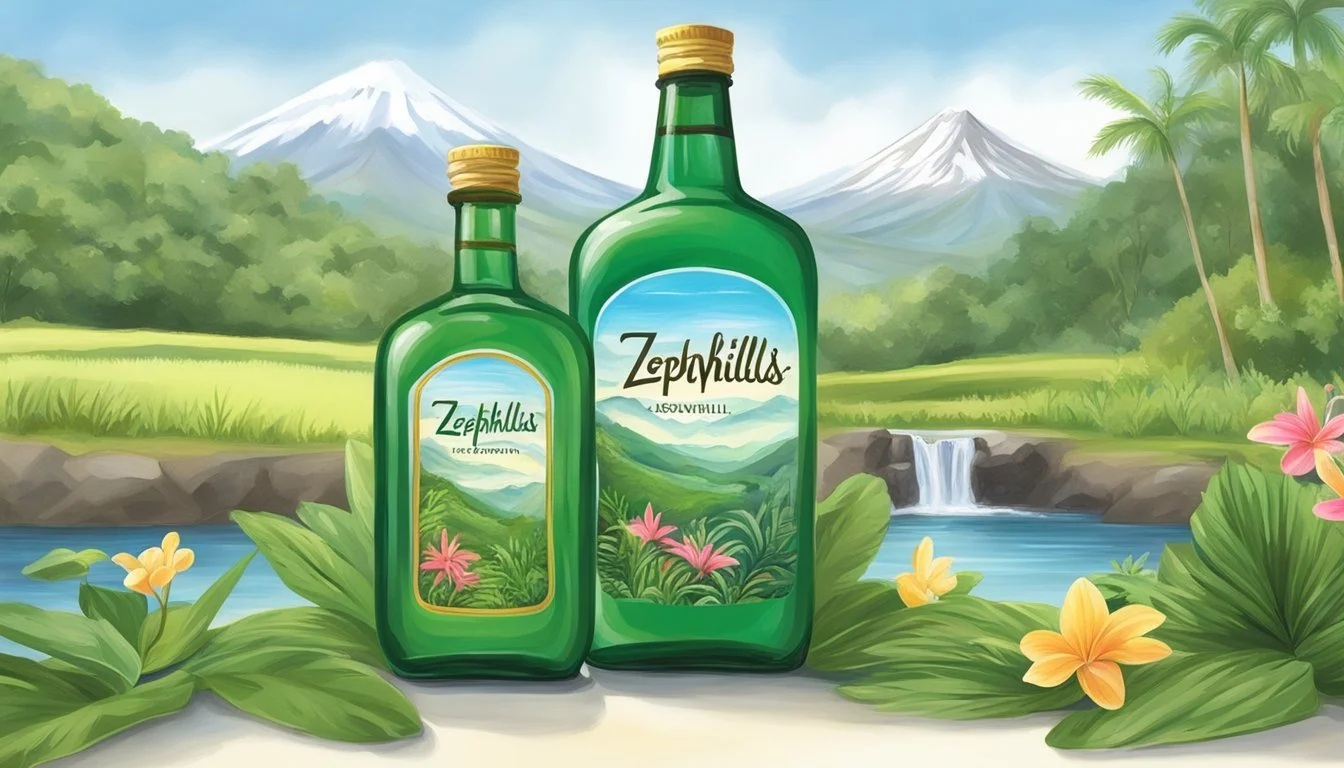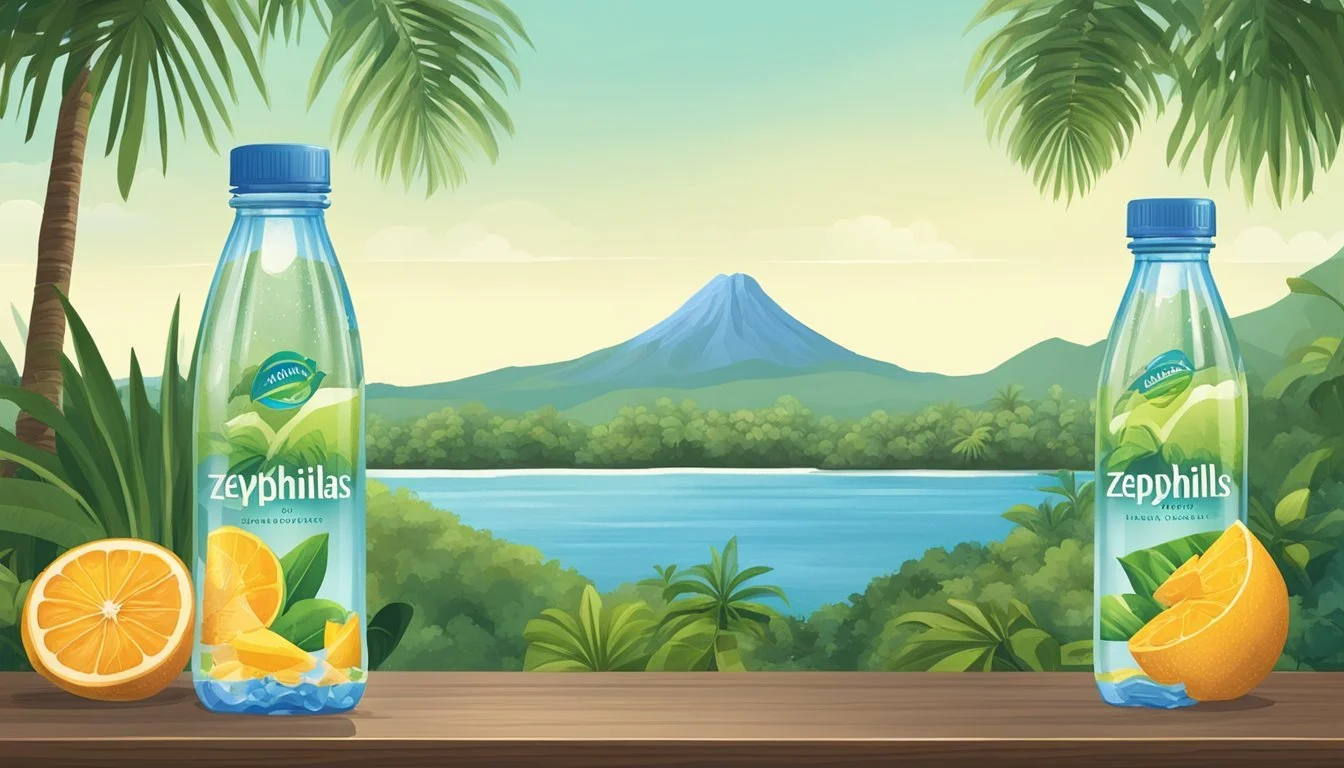Zephyrhills vs. Hawai’i Volcanic
Comparing Top Bottled Waters
When it comes to choosing the best bottled water, the debate between Zephyrhills and Hawai’i Volcanic presents a fascinating contrast. Zephyrhills offers a crisp, refreshing taste sourced from natural springs in Florida, making it a popular choice for those who value pure spring water. On the other hand, Hawai’i Volcanic boasts a unique mineral composition, sourced from the volcanic regions of Hawaii, providing not just hydration but a distinctive flavor profile enriched with essential minerals.
Zephyrhills has built a reputation for its clean, light taste that appeals to a broad audience. This brand is renowned for its accessibility and affordability, maintaining high-quality standards while being widely available. For consumers looking for an everyday hydration solution, Zephyrhills represents a reliable and straightforward option.
In contrast, Hawai’i Volcanic offers an exotic touch with its volcanic water origins. Its premium positioning is reflected in both its price and its mineral-rich content, appealing to those who seek a unique drinking experience. Whether you prefer the straightforward purity of Zephyrhills or the mineral-enhanced taste of Hawai’i Volcanic, making an informed choice can elevate your daily hydration ritual.
The Essence of Bottled Water
Bottled water offers a convenient way to stay hydrated. It comes in various forms such as plastic bottles, glass bottles, and even cartons. The choice of material can impact environmental sustainability, as well as customer preference.
Plastic bottles are highly popular due to their lightweight nature and low cost. They often use rPET (recycled polyethylene terephthalate), enhancing their recyclability.
Glass bottles, though heavier and more fragile, appeal to those seeking an eco-friendly and taste-neutral option. Glass does not impart any flavor to the water, maintaining its purity.
Hydration is the primary goal with bottled water, providing a readily available source of clean, safe drinking water. Different brands offer varying levels of minerals and electrolytes, such as calcium, magnesium, and potassium, contributing additional health benefits.
Convenience is another significant factor. Bottled water can be easily transported and stored, making it a staple for activities ranging from office work to outdoor adventures.
When choosing bottled water, consumers may consider both the material and the mineral content to suit their personal and environmental needs.
Sourcing the Springs
The sources of Zephyrhills and Hawai’i Volcanic bottled waters are distinct, showcasing the unique characteristics of their respective environments. These specifics highlight how the origins impact the quality and composition of the water.
Zephyrhills’ Aquifer Origins
Zephyrhills natural spring water is harvested from aquifers located in Florida. The region is known for its deep underground water reservoirs that provide a steady supply of pure water.
These aquifers are recharged by rainfall, filtered naturally through layers of soil, limestone, and sand. This natural filtration process enriches the water with minerals that enhance its taste.
The historical significance of these water sources lies in their consistent quality and purity. The management of these aquifers ensures sustainable harvesting practices that maintain the balance of the local ecosystem.
Hawai’i Volcanic Natural Filtration
Hawai’i Volcanic sources its water from volcanic springs in Hawaii. The islands' volcanic activity creates a unique filtration system that involves porous lava rock.
As rainwater percolates through these volcanic layers, it undergoes a natural filtration process that removes impurities while adding essential minerals. This gives the water a slightly alkaline pH level typically ranging from 7.7 to 8.4.
The pristine water from these volcanic springs reflects the purity and natural filtration benefits provided by the ancient volcanic formations. This unique sourcing method contributes to the distinct taste and health properties associated with Hawai’i Volcanic bottled water.
Quality and Purity
Both Zephyrhills and Hawai’i Volcanic offer bottled water products that emphasize quality and purity, appealing to different preferences in taste, mineral content, and filtration processes.
Taste and Texture
Zephyrhills water is sourced from Florida springs and is known for its crisp, clean taste. Its natural mineral content adds a subtle flavor, making it refreshing and well-balanced. The texture feels smooth, without any noticeable aftertaste.
Hawai’i Volcanic features a distinct taste, attributed to its volcanic rock filtering. This method imparts a unique, slightly alkaline flavor that many find appealing. The water’s texture is silky, offering a light and refreshing mouthfeel that adds to its drinking experience.
Mineral Content and Health Benefits
Zephyrhills contains essential minerals such as calcium, magnesium, and potassium, contributing to its crisp taste. These minerals support overall hydration and can benefit bone health and muscle function. The natural spring source ensures the retention of these beneficial minerals in their original form.
Hawai’i Volcanic boasts a higher pH level, ranging from 7.7 to 8.4, making it alkaline. This alkalinity is believed to neutralize stomach acid and provide other potential health benefits like improved hydration and detoxification. Its mineral content includes silica, which supports skin health and improves water absorption in the body.
Filtration and Purification Processes
Zephyrhills uses a multi-step filtration process involving carbon filtration and ultraviolet light to ensure purity. This process removes impurities while preserving the natural mineral content. Their commitment to sustainability is reflected in their efforts to manage spring sources effectively to reduce environmental impact.
Hawai’i Volcanic undergoes natural filtration through layers of volcanic rock, which helps in achieving its unique mineral composition and alkaline nature. This natural process ensures that the water remains pure and mineral-rich without the need for extensive artificial filtration. Consequently, the water retains its beneficial properties while maintaining high purity and taste standards.
Environmental Considerations
In evaluating the environmental impact of Zephyrhills and Hawai’i Volcanic, key factors include their sustainability practices, packaging choices, and efforts to preserve natural ecosystems.
Sustainability Practices
Zephyrhills sources its water from natural springs in Florida. To reduce environmental impact, they implement water conservation measures at the spring sites. For instance, they have reported efforts to ensure sustainable water levels by monitoring aquifers.
Hawai’i Volcanic takes a holistic approach. They focus on clean energy use in their production facilities and support local conservation projects. The brand’s commitment to renewable energy and environmental stewardship aims to mitigate the overall environmental footprint of their operations.
Both companies have made strides in environmental responsibility, yet their specific initiatives reflect different regional and operational focuses.
Packaging Impact
Zephyrhills and Hawai’i Volcanic both utilize plastic bottles, contributing to plastic waste. Zephyrhills incorporates a significant portion of recycled plastic into its bottles, promoting a circular economy. They actively encourage recycling through awareness campaigns.
By contrast, Hawai’i Volcanic emphasizes the use of glass bottles, which are fully recyclable and have a lower environmental impact if recycled properly. This choice aligns with their sustainability ethos, despite the higher production costs associated with glass.
The packaging material selected by each brand impacts the environment differently: Zephyrhills focuses on reducing the environmental burden of plastic, whereas Hawai’i Volcanic opts for a more sustainable material choice.
Ecosystem Preservation
Zephyrhills protects its spring sites by implementing practices that maintain the natural environment of the springs and surrounding areas. This includes protecting local wildlife and maintaining water quality.
Hawai’i Volcanic invests in local conservation efforts in Hawaii. They support reforestation projects and protect volcanic aquifers through sustainable extraction practices.
Both brands share a commitment to preserving natural habitats. Zephyrhills focuses on safeguarding the Florida springs, while Hawai’i Volcanic invests in the unique ecosystem of the Hawaiian islands. These practices highlight their dedication to minimizing ecological disruption and promoting biodiversity.
Nutritional Comparison
To help consumers make an informed choice between Zephyrhills and Hawai’i Volcanic, this section explores the nutritional aspects of each brand, focusing on electrolytes, minerals, alkalinity, and pH balance.
Electrolytes and Minerals
Both Zephyrhills and Hawai’i Volcaniz contain electrolytes essential for maintaining fluid balance and nerve function. Zephyrhills, being natural spring water, has naturally occurring minerals like calcium, magnesium, potassium, and sodium. These minerals contribute to the water's distinct taste and health benefits.
Hawai’i Volcanic, on the other hand, emphasizes its mineral content, listing minerals such as calcium, magnesium, and potassium. This water also contains a unique blend of trace minerals that come from volcanic rocks, enhancing the nutritional profile.
Alkalinity and pH Balance
Hawai’i Volcanic stands out with a higher pH range, typically between 7.7 to 8.4, classifying it as alkaline water. This higher pH level can neutralize stomach acid and is often considered beneficial for hydration and overall well-being.
Zephyrhills' pH level falls between 6.5 and 8.5, aligning with the ideal pH balance for drinking water. The pH range indicates that Zephyrhills can vary from neutral to slightly alkaline, contributing to its refreshing taste and potential health benefits.
By comparing the two brands, consumers can decide based on their preferences for electrolytes, minerals, and pH balance.
Taste Perfected
Taste is often the deciding factor for most consumers when choosing between bottled waters. Zephyrhills and Hawai’i Volcanic present distinct taste profiles that cater to different preferences and palates.
Consumer Preferences
Zephyrhills water is known for its fresh and clean taste, appreciated by those who enjoy a light and crisp finish. This water is often praised for its neutral pH, which contributes to its consistent and smooth flavor.
In contrast, Hawai’i Volcanic offers a smooth and slightly alkaline taste that appeals to consumers looking for a more refined and balanced experience. Its taste is often described as refreshing with a subtle hint of minerality that provides a unique character.
Water Sommelier Insights
Experts note that Zephyrhills' crisp and clean taste profile stems from its natural springs, delivering a pure and unadulterated water experience. They highlight its balanced mineral content as key to its popular light finish.
Hawai’i Volcanic, on the other hand, undergoes a natural filtration process through volcanic rock, which enriches the water with essential minerals. This process contributes to its smooth and light taste, enhanced by its slightly higher pH. Sommeliers commend its refined flavor, making it a top choice for premium water enthusiasts.
Brand Analysis
This section explores Zephyrhills and Hawai’i Volcanic through their market presence, consumer trust, and the comparative cost and value of their bottled water products.
Market Presence and Consumer Trust
Zephyrhills, a well-known brand in the southeastern United States, is widely available in grocery stores and supermarkets. Its reputation for delivering quality spring water makes it a popular choice among consumers. Owned by Nestlé, Zephyrhills benefits from the credibility and marketing strength of a major conglomerate.
In contrast, Hawai’i Volcanic targets the premium bottled water segment. Known for sourcing water from volcanic springs, it appeals to a niche but growing market. Though less ubiquitous than Zephyrhills, it is found in select high-end stores and online retailers. The brand enjoys a loyal following, particularly amongst health-conscious consumers seeking alkaline water.
Comparative Cost and Value
Zephyrhills is generally more affordable, catering to a broad market. The cost efficiency, combined with frequent availability in bulk at grocery stores, makes it a convenient and economical choice for families and individuals. This affordability has helped it maintain a strong market presence.
Hawai’i Volcanic, marketed as a premium option, comes with a higher price tag. The brand emphasizes its unique volcanic source and higher pH levels, which some consumers believe offer additional health benefits. Despite its higher cost, the perceived value justifies the expense for those seeking premium water.
In summary, consumers choosing between Zephyrhills and Hawai’i Volcanic must weigh the cost against the perceived benefits, brand reputation, and specific preferences for premium quality and potential health advantages.
More About Zephyrhills
Core Hydration vs Zephyrhills: Which Bottled Water is Better?
Icelandic Glacial vs Zephyrhills: Which Bottled Water is Better?
Mountain Valley Spring Water vs Zephyrhills: Which Bottled Water is Better?
Nestle Pure Life vs Zephyrhills: Which Bottled Water is Better?
Poland Spring vs Zephyrhills: Which Bottled Water is Better?
San Pellegrino vs Zephyrhills: Which Bottled Water is Better?
Zephyrhills vs Aqua Carpatica: Which Bottled Water is Better?
Zephyrhills vs Cascade Mountain: Which Bottled Water is Better?
Zephyrhills vs Crystal Geyser: Which Bottled Water is Better?
Zephyrhills vs Hawaiian Springs: Which Bottled Water is Better?
Zephyrhills vs Kirkland Signature: Which Bottled Water is Better?
Zephyrhills vs Purely Sedona: Which Bottled Water is Better?
Zephyrhills vs Richard's Rainwater: Which Bottled Water is Better?
Zephyrhills vs Solan de Cabras: Which Bottled Water is Better?
Zephyrhills vs Talking Rain AQA: Which Bottled Water is Better?
Zephyrhills vs Whole Foods 365: Which Bottled Water is Better?
Zephyrhills vs Whole Foods Italian Still Mineral water: Which Bottled Water is Better?
More About Hawai’i Volcanic
Acqua Pana vs Hawaii Volcanic: Which Bottled Water is Better?
Antipodes vs Hawaii Volcanic: Which Bottled Water is Better?
Aqua Carpatica vs Hawaii Volcanic: Which Bottled Water is Better?
Arrowhead vs Hawaii Volcanic: Which Bottled Water is Better?
Boxed Water vs Hawaii Volcanic: Which Bottled Water is Better?
Castle Rock vs Hawaii Volcanic: Which Bottled Water is Better?
Core Hydration vs Hawaii Volcanic: Which Bottled Water is Better?
Deer Park vs Hawaii Volcanic: Which Bottled Water is Better?
Hawaii Volcanic vs 1907water: Which Bottled Water is Better?
Hawaii Volcanic vs Alkaline88: Which Bottled Water is Better?
Hawaii Volcanic vs Big Chill: Which Bottled Water is Better?
Hawaii Volcanic vs BodyArmor: Which Bottled Water is Better?
Hawaii Volcanic vs Cascade Mountain: Which Bottled Water is Better?
Hawaii Volcanic vs CBD Living: Which Bottled Water is Better?
Hawaii Volcanic vs Crystal Geyser: Which Bottled Water is Better?
Hawaii Volcanic vs Crystal Lake: Which Bottled Water is Better?
Hawaii Volcanic vs Essence pH10: Which Bottled Water is Better?
Hawaii Volcanic vs Kirkland Signature: Which Bottled Water is Better?
Hawaii Volcanic vs Liquid Death: Which Bottled Water is Better?
Hawaii Volcanic vs Open Water: Which Bottled Water is Better?
Hawaii Volcanic vs Proud Source: Which Bottled Water is Better?
Hawaii Volcanic vs Pure Life: Which Bottled Water is Better?
Hawaii Volcanic vs Purely Sedona: Which Bottled Water is Better?
Hawaii Volcanic vs Richard's Rainwater: Which Bottled Water is Better?
Hawaii Volcanic vs Simple Truth: Which Bottled Water is Better?
Hawaii Volcanic vs Talking Rain AQA: Which Bottled Water is Better?
Hawaii Volcanic vs Weird Water: Which Bottled Water is Better?
Hawaii Volcanic vs Whole Foods 365: Which Bottled Water is Better?
Hawaii Volcanic vs Whole Foods Italian Still Mineral water: Which Bottled Water is Better?
Hawaiian Springs vs Hawaii Volcanic: Which Bottled Water is Better?
Ice Mountain vs Hawaii Volcanic: Which Bottled Water is Better?
Icelandic Glacial vs Hawaii Volcanic: Which Bottled Water is Better?
Just Water vs Hawaii Volcanic: Which Bottled Water is Better?
Mountain Valley Spring Water vs Hawaii Volcanic: Which Bottled Water is Better?
Nestle Pure Life vs Hawaii Volcanic: Which Bottled Water is Better?
Poland Spring vs Hawaii Volcanic: Which Bottled Water is Better?
San Pellegrino vs Hawaii Volcanic: Which Bottled Water is Better?
Smartwater vs Hawaii Volcanic: Which Bottled Water is Better?
Solan de Cabras vs Hawaii Volcanic: Which Bottled Water is Better?
Topo Chico vs Hawaii Volcanic: Which Bottled Water is Better?








